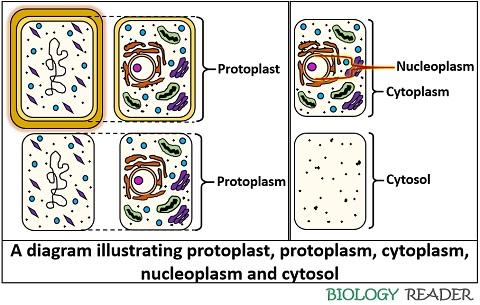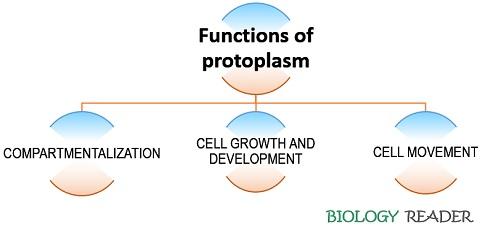Protoplasm is a term used to indicate the living matter of the cell which includes the cytoplasm and the nucleus. It is a colourless colloidal suspension of lipids and proteins in water. It was put forward in the year 1835 and was primarily considered as the ground substance of the cell.
But these days, two separate terms, i.e. cytoplasm and nucleoplasm, are used to represent the two major divisions of a cell. A selective membrane surrounds the protoplasm (in eukaryotes), whereas in prokaryotes it is surrounded by a selective cell membrane, cell wall and sometimes capsule.
Content: Protoplasm
Definition of Protoplasm
Protoplasm refers to the living matter of the cell, which is a collective term used for the combination of cytoplasm and nucleoplasm. It is the protoplasmic fluid, which comprises nucleic acids, various proteins, lipids, carbohydrates, inorganic salts and water droplets.
It is sometimes interchangeable with the terms like protoplast, cytoplasm and nucleoplasm. As the prokaryotic cell is devoid of the cell nucleus and the remaining part is known as the prokaryotic cytoplasm.

Oppositely, a eukaryotic cell is partitioned into a spherical nucleus and homogenous cytoplasm. Therefore, the protoplasm in the middle of the cell membrane and nucleus will be termed “Cytoplasm”. Similarly, the protoplasm accumulated inside the cell nucleus will be called “Nucleoplasm”.
Components of the Cell Protoplasm
In eukaryotes, the protoplasm has two major divisions, i.e. cytoplasm and nucleus.
Primary Element
The cytoplasm is the primary element of the cell protoplasm, which constitute a significant part of the cell. It is a fluid that contains both suspended and dissolved living matter. Cytoplasmic organelles like mitochondria, Golgi body, ribosomes etc. are found within the cytosol.
A cytoplasm includes 90% of water, 7% proteins, 2% carbohydrates and 1% inorganic minerals. It provides a favourable environment for many biochemical reactions and life processes. There are three main properties of cytoplasm:
Watery: A cytosol comprises a transparent or homogenous fluid, which absorbs the light to make the organelles visualize to us under a light microscope. We can suppose a live example by taking a glass of water and a glass of milk. If we add any solid substance like a pin, then we can easily visualize the pin in water instead of milk.
Motion: The organelles of a plant and animal cell are in a continuous moving state because of the fluid nature of the cytosol.
Living matter: A cytoplasm contains the living matter as the organelles within the cytosol are in continuous motion. Therefore, the living nature of cells is primarily characterized by the movement of cytoplasmic contents as per the cytoplasmic reactions. In contrast, a cell is considered as dead if the organelles are metabolically inactive.
Secondary Element
A cell nucleus is the second component of the protoplasm, which is the control unit of all the eukaryotic cells. It contains a heritable material within, which is transferred from the parent cell to the daughter cells.
All the life processes like growth, reproduction, metabolism etc. are controlled by the genes found within the chromosome content of the nucleus. It primarily comprises a nucleoplasm, which is encircled by a nuclear membrane.
We can easily observe the characteristic difference between the terms, viz. protoplast, protoplasm, cytoplasm, nucleus and cytosol. People might get confused with the terms protoplast and protoplasm, but we can easily remember both the terms by looking at the picture given below:

Looking at the picture, we can define protoplast as the combination of the cell membrane, cytoplasm plus nucleus and protoplasm as the combination of cytoplasm and nucleoplasm only.
Similarly, a protoplasm without a nucleus will be termed a cytoplasm (including cytoplasmic organelles), and a protoplasm embedded within the nucleus will be called a nucleoplasm. At last, a cytosol is the rest of the fluid that is without cell organelles.
Properties
- It only indicates the living component of the cell.
- In eukaryotes, a protoplasm categorizes into two components, i.e. cytoplasm and nucleus.
- In prokaryotes, the whole cytoplasm is considered the prokaryotic protoplasm.
- It is composed of polar substances (like water), micromolecules (like ions, inorganic salt, monosaccharides, amino acids etc.) and macromolecules (like proteins, lipids, nucleic acid, and polysaccharides).
- It contains all the organic and inorganic elements which are necessary for building up the new cells.
- A protoplasm embedded within the nucleus and the part accumulated within the cell membrane and nucleus is termed as nucleoplasm and cytoplasm, respectively.
- The viscosity of protoplasm is very much similar to the concentrated protein solution, and it is mainly due to the granular content of the cytoplasm.
Video: Protoplasm
Protoplasm Theory
Before the protoplasm theory, many cell biologists had given their contribution to study the term protoplasm. Up to the mid-19th Century, all were indulged in studying the cell wall instead of cell contents. Later, cell biologists started investigating the cellular contents.
| Year | Discoverer | Discovery |
|---|---|---|
| 1835 | Felix Dujardin | He performed experiments on the protozoa and termed a name “Sarcode” for the jelly-like substance within the cell |
| 1839 | J.E. Purkinje | He studied the animal embryo and coined a term “Protoplasm” |
| 1846 | H.von Mohl | He studied on the plant embryonic tissues and used a term protoplasm instead of sarcode |
| 1861 | Max Schultze | He studied the similarities between the sarcode and protoplasm of both the animal and plant cell |
| 1892 | O. Hertwig | He proposed a protoplasm theory (advance to the cell theory) |
Postulates of Protoplasm Theory
This theory explains that the protoplasm is the physical basis of life. It is an improved theory over the cell theory given by the scientists named, Schleiden and Schwann.
- All the living content from which the plant, as well as animal cells, originate is called the protoplasm.
- Cells form by the accumulation of the living matter or protoplasm.
- Protoplasm is a viscous fluid that includes the cytoplasm along with the nucleoplasm. Protoplasm inside the nucleus and in the middle of the plasma membrane and nucleus is called nucleoplasm and cytoplasm, respectively.
After this, a more advanced Organismal theory was proposed by Sachs, which explains that organisms are the basic unit of life.
Functions of Cell Protoplasm
A cell protoplasm has many fractions or subcompartments, which significantly perform the distinct task and serve as the moving and the reproducing apparatus.

Compartmentalization
A protoplasm is compartmentalized into discrete structures that mediate specific tasks within a cell. We can understand this by taking some of the examples:
- Production of glucose during photosynthesis occurs at the site of a specialized compartment, which is known as chloroplast.
- Aerobic respiration occurs within the subcellular structure that is called mitochondria.
- The packaging of DNA occurs inside a bilayer membranous structure, which is called the nucleus.
- Protein synthesis occurs specifically by the macromolecular complex, which is known as the ribosome.
- The ribosomal synthesis occurs particularly within the sub-structure found in the nucleus that is called the nucleolus.
Therefore, the compartmentalization within the cell is a prominent feature of eukaryotes and uncommon in prokaryotes. The intracellular structures or compartments are mainly known as cellular or cytoplasmic organelles.
Hence, the organelles within the cytoplasm of a eukaryotic cell show a division of labour, in which each compartment is specialized to do specific tasks.
The double-layered membrane bounds some cell organelles like the nucleus, ER, Golgi apparatus, mitochondria and plastids. A few of the cell organelles are bound by a single membrane (lysosomes) and a non-unit membrane (ribosomes and centrioles).
Cell Growth and Development
A protoplasm has a considerable carbon content, which functions as the basic building block of the cell. The carbon content is harnessed by a cell to produce complex molecules and macromolecular complexes, which are required for the regular function of the cell.
Inside the cytoplasm, the micromolecules polymerize to form complex macromolecules, which in turn assemble to form a supramolecular structure.
Later, these structures constitute the formation of macromolecular complexes and intracellular organelles, which create a complete, functional cell.
The formation of the cell from the cellular components is called the molecular hierarchy. A plant cell can prepare fresh protoplasm by using the mineral compounds. Animals are obliged to procure it readymade through the plants.
Cell Movement
The movement can define as the action of some reaction. Here, the action toward the particular reaction will be termed as “Response“, and the reaction towards action will be termed as “Stimulus“.
The process of movement is common in animals, but plants use different mechanisms to move. The movement in plants can be artificially induced by some physical and chemical means, or it can occur spontaneously by the protoplasm.
The protoplasmic movements by the plant cells are considered “Vital movements“, which occurs due to the irritability and contractibility of protoplasm, like an animal cell.
Spontaneous movement in plants includes ciliary (Volvocales), amoeboid (plasmodia of myxomycetes) and cyclosis (chloroplast of Hydrilla).
Conclusion
Therefore, we can conclude that the cell protoplasm is the organization of discrete compartments, which may or may not possess a nucleus.
Protoplasm is simple (in prokaryotes) and complex and nucleated (in eukaryotes). The cellular contents of the protoplasm provide all the elements, which are necessary for cell growth and development.